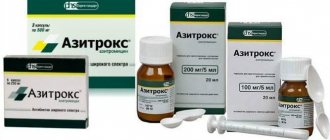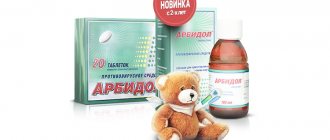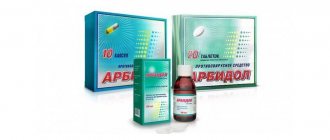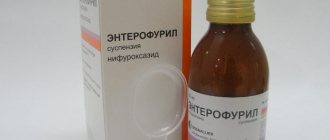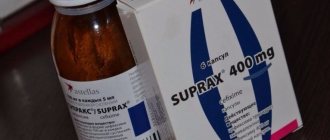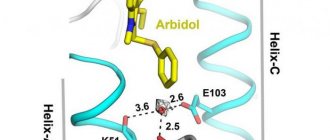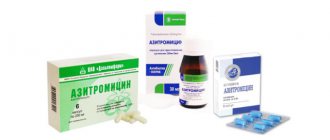Release form
Hemomycin is available in four types:
- Capsules. Externally, they have a hard gelatinous light blue shell, and inside there is a white powder. There are 6 capsules in a blister, 1 blister in a package.
- Pills. Covered with a film shell, gray-blue in color, biconvex. There are usually 3 tablets in a blister, and 1 blister in a cardboard package.
- The powder from which the suspension is made. Its color is white or very close to it, with a fruity smell. The package contains a dark bottle, the weight of the powder is 10-12 g. A measuring spoon is included.
- A special form of the drug for injection .
Operating principle
Chemomycin is a broad-spectrum bactericidal antibiotic. Azithromycin inhibits protein synthesis at the cellular level in pathogenic microorganisms. As a result, it helps block the proliferation of many bacteria.
It is active in the fight against aerobic gram-positive bacteria. These include streptococci, gonococci, staphylococci, listeria. It is also active against aerobic gram-negative bacteria, anaerobic bacteria. This drug is active against intracellular microorganisms - chlamydia trachomatis, mycoplasma, ureaplasma, etc. Improvement is observed in patients whose disease was caused by obligate intrapulmonary microorganisms, for example, mycoplasma, chlamydia, legionella.
The drug does not act on gram-positive bacteria that are resistant to erythromycin.
Contraindications for use
Like any other drug, Hemomycin suspension for children has some restrictions on use. It is not recommended to be given to young patients in the following cases:
- hypersensitivity to the components included in the drug;
- intolerance to macrolide antibiotics;
- liver diseases and violation of its detoxification function;
- kidney dysfunction.
The medication should be prescribed with caution to patients with heart rhythm disturbances, myasthenia gravis, or dehydration. The attending physician should tell you about all existing restrictions.
Indications
Inflammatory and infectious diseases caused by microorganisms that are sensitive to this drug:
- Infections of the ENT organs and upper respiratory tract. These include sinusitis, otitis media and tonsillitis.
- Infections of the urogenital tract.
- Infections of the skin and soft tissues, such as impetigo, secondary infected dermatitis.
- Scarlet fever.
- Diseases of the intestines and duodenum caused by the bacterium Helicobacter pylori.
- Lower respiratory tract infections (bronchitis, bacterial pneumonia).
- Treatment for early stages of Lyme disease.
At what age can it be approved for use: Hemomycin can be used from six months of age.
Adverse reactions
- Allergic: itching, urticaria, conjunctivitis.
- In the central nervous system: insomnia, headache, anxiety, sleep disturbance, neurosis.
- In the digestive system: stomach pain, nausea, gastritis, flatulence, vomiting, cholestatic jaundice, candidiasis of the oral mucosa, increased liver enzymes, diarrhea or constipation, change in taste.
- From the urinary and reproductive system: nephritis, vaginal candidiasis.
- In the cardiovascular system: chest pain, rapid heartbeat.
Hemomycin 250: instructions for use and dosage for children
The instructions imply the use of this medicine once a day in between meals. Ideally, 1 hour before or 2 hours after meals. Such requirements were formed due to the fact that the active substances of the antibiotic are poorly absorbed with food.
Capsules Hemomycin 250
The recommended antibiotic dosage for children over 12 years of age for infections of the lower and upper respiratory tract, as well as soft tissues and skin, is 10 mg/kg once a day. The recommended duration of treatment is 3 days. Considering the peculiarities of the course of the disease, it is worth relying on the doctor’s prescription.
Hemomycin tablets
Can be prescribed to adults and children over 12 years of age for infections of the lower and upper respiratory tract at a dosage of 500 mg/day for 3 days.
- For acute uncomplicated urethritis, the doctor may prescribe the drug in a single dose of 1 g.
- For stomach diseases caused by the bacterium Helicobacter pylari, 1 g per day is prescribed for 3 days.
Instructions for use of Hemomycin suspension for children 200 mg/5 ml and 100 mg/5 ml
An antibiotic with a concentration of 200 mg/5 ml is recommended for use in children over 12 months of age. And for children from 6 months – 100 mg/5 ml. For children of this age, the dosage of Hemomycin is 10 mg/kg once a day for 3 days.
The suspension is prepared as follows: first you need to prepare the water - boil it and cool it. Pour prepared water into the bottle (or you can use distilled water) to the desired level and shake thoroughly until smooth. The suspension must be shaken before each use.
The diluted medicine can be stored at room temperature for up to 5 days. The instructions also ask you to pay attention to the fact that after using the medicine, the baby must be given a few sips of water or other liquid to completely wash it off from the mouth and get it inside.
Overdose
Symptoms of overdose may include: temporary hearing loss, nausea, vomiting, diarrhea. In this case, it is necessary to perform gastric lavage and symptomatic therapy.
Cooking rules
Preparing the suspension is quite simple. Having boiled and cooled a small amount of water to room temperature, add 14 milliliters of liquid to the bottle with the antibiotic and shake the container several times, carefully monitoring the homogeneity of the mixture - the drug should dissolve well, the presence of individual granules in the mass is unacceptable.
If the level of the medicine is below the mark marked on the wall of the bottle, then you need to add additional water and re-mix the suspension.
The medicine prepared in this way can be stored in a cool place for 5 days.
Each dose of the drug is washed down with a small amount of liquid (water, fruit juice).
- Chemomycin: drug analogues and their brief description;
- Read here - Hemomycin or Sumamed - which is better and in what cases;
- Dosage of Chemomycin for children: https://med-antibiotiks.com/instrukcii/analogi-antibiotika-sumamed-obzor-svojstv/.
How does it interact with other drugs?
- With the simultaneous use of magnesium and aluminum containing drugs with Hemomycin, absorption of azithromycin is observed.
- The process of absorption of azithromycin is slowed down by ethanol and food.
- The combined use of digoxin and azithromycin significantly increases the concentration of the former.
- The drug struggles with lincosamides, cephalosporins, and antibiotics of the penicillin group.
- The main component of the antibiotic, azithromycin, is incompatible with heparin.
- But it enhances the effects of tetracyclines, sulfonamides, and streptomycin.
Reviews of Hemomycin suspension for children
Most often you can find positive reviews about the drug on pharmaceutical websites. This helps to form a good assessment of its effectiveness and quality. Most often, young parents write about malfunctions in the gastrointestinal tract, and this is its only disadvantage. Therefore, if any symptoms appear, you should immediately contact your doctor to adjust the dosage or even change the medication.
Here are some reviews and recommendations that will help you get a complete picture of this drug:
Zhanna:
On the 4th day of taking the antibiotic, the child showed no improvement. Sometimes they write that the effect can occur after finishing the entire course, but we did not wait for it. We went to the pediatrician for a new prescription and prescribed injections. Based on my personal experience, I can say that this antibiotic does not help everyone.
Natalia:
My daughter refused to take Hemomycin, despite the fact that she diluted it with tea and compote, and constantly spat it out. As a result, she did not drink the full portion. But I can note that in combination with other drugs there was an effect, and the cough subsided.
Alina:
He helped my child more than once in the treatment of scarlet fever, bronchitis and purulent sore throat. In addition, the price is reasonable, and you only need to use it for 3 days, and then only once a day. We had no side effects. I can confidently recommend it only after prior consultation with a doctor. One piece of advice: if you are offered Sumamed in a pharmacy, then know that there is no difference in effectiveness, but the price of the latter is almost twice as high.
Victoria:
A very effective drug. We drank it twice and were satisfied, since it did not cause any side effects, and improvement occurred by the middle of the second day. And the price is quite reasonable.
Irina:
The downside of this antibiotic for me is that after shaking, the product remains on the walls, and after that it does not reach the desired level. In this regard, it turns out that by the last dose only half the dose remains. And given that the course of administration is short, I am worried that its action will not be enough to defeat viruses. But while taking it I overcame my cold, leaving only a slight cough and runny nose. Its advantage is that Hemomycin does not affect the intestines, as happens when taking antibiotics.
Pharmacodynamics and pharmacokinetics
The principle of action of the drug is based on the mechanisms of inhibition of vital biochemical reactions occurring in cell membranes. In particular, after starting to take azithromycin, protein synthesis is suppressed due to the connection of the substance with the 50S ribosomal subunit.
The result of this interaction is the blocking of peptide translocase, leading to a slowdown in the growth and reproduction of pathogenic flora.
Azithromycin in high concentrations is effective against any type of microbe, however, some microorganisms may initially be resistant to the antibacterial component of Hemomycin.
As for the pharmacokinetic properties of azithromycin, it is worth noting the rapid absorption of this substance from the gastrointestinal tract. The reaction rate is due to its hydrophobicity and resistance to acidic environments.
After the substance enters the gastrointestinal tract in an amount of 500 mg, it reaches its maximum concentration after 3 hours. In the blood serum, the level of azithromycin is 0.4 mg/l with a bioavailability of at least 35%.
Chemomycin in the form of a suspension for children easily penetrates through the bloodstream into the respiratory system, inside the kidneys and urinary tract, bladder, and pelvic organs. Moreover, in soft tissues the concentration of azithromycin can be tens of times higher than its amount in plasma.
Due to the long half-life, the binding of azalide to blood proteins occurs rather slowly. This is also due to the penetrating properties of azithromycin: the antibiotic enters and accumulates inside eukaryotic cells only at low pH levels.
It is also worth noting the ability of azithromycin to concentrate in the structure of lysosomes, which is of particular importance for the complete elimination of infection.
Researchers were able to prove that the antibiotic is transported by phagocytes to areas of accumulation of pathogenic agents, where the substance is subsequently released during phagocytosis. At the same time, a large amount of azithromycin in phagocytes does not affect their work.
The metabolic half-life of Chemomycin occurs in the liver, and the elimination of its active components requires at least 35 hours. In its original form, no more than 60% of azithromycin is excreted, with most of it leaving the body in feces, and the rest in urine.
Analogs
- Suprax . This is a potent third-generation antibiotic; it can be used from 6 months. It has a fairly wide spectrum of action. But it is prescribed by doctors only when less powerful drugs do not work. Its price is an order of magnitude higher than that of Hemomycin. But, at the same time, this antibiotic copes with any kind of disease, including sore throat in children.
- Zinnat. It is allowed to be used from the age of three months. This drug acts on the causative agent of infections selectively: on some people more strongly, on others less, it may not work at all.
- Amoxicillin. This drug is prescribed for any age. However, it is not very effective in the fight against certain types of staphylococci and a number of other viruses, but this antibiotic is most often prescribed for bronchitis in children.
Analogues of Hemomycin for the active substance are:
- Sumamed - sold both in tablets and capsules, and in granules for dilution with water and preparation of a suspension. Recommended for use from 6 months. As for the price, it is slightly inferior to Hemomycin.
- Ecomed . This antibiotic is also available in three of the same forms as Sumamed or Hemomycin. Can be recommended for use from 6 months.
Drug interactions
Chemomycin is a suspension for children, which, like any other potent antibacterial drugs, interacts differently with representatives of other pharmacological groups. Moreover, various combinations of medications do not always have a beneficial effect on the child’s well-being.
As noted earlier, antacids should not be used concomitantly with azithromycin. Otherwise, the absorption of the antibiotic will slow down, and the therapeutic effect will occur much later. Absorption of Hemomycin occurs in a similar way when taking medications containing ethanol.
Azithromycin cannot be used together with cardiac glycosides (for example, digoxin), since the risk of overdose with this drug and an increase in its concentration in the blood serum increases.
The antibiotic increases the rate of absorption and reduces the rate of excretion from the body of anticoagulants, glucocorticosteroids, phosphodiesterase inhibitors, dopamine receptor stimulants and oral hypoglycemic substances.
Under no circumstances should Hemomycin be taken with heparin medications due to their pharmacological incompatibility. Despite the lack of confirmed information about the interaction of azithromycin with ergotamine and its derivatives, it is undesirable to use them simultaneously in order to avoid the risk of developing ergotism - poisoning with ergot alkaloids.
Features of antibiotic use in children
There are several rules that must be followed when using them:
- you cannot decide to prescribe them or stop using them on your own; this must be discussed with your doctor;
- you must strictly follow the indicated dosage;
- you should not stop using the drug before the permissible period, even if you see minor improvements;
- provide the baby with bed rest;
- ventilate the room regularly;
- carry out wet cleaning;
- exclude spicy, fried, salty foods from his diet.
After taking antibiotics, you need to help restore the intestinal microflora and immunity with the help of drugs with live bacteria - probiotics. Usually the body needs 5-10 days to return to normal.
special instructions
As noted earlier, one of the possible side effects is patient hypersensitivity to azithromycin. When using macrolides, patients may experience complex allergic reactions in the form of angioedema or anaphylaxis, as well as skin lesions, including a generalized form of exanthematous pustulosis and necrolysis.
In some cases, negative reactions that occur when using Hemomycin become chronic.
The initial stage of allergy to the drug is the basis for its discontinuation and initiation of appropriate antihistamine therapy. After stopping the antibiotic, allergenic symptoms may go away without drug intervention.
Hemomycin suspension for children
Before starting to use an antibacterial drug, the doctor should refer the patient for a bacteriological examination to identify refractory pathogens and fungal infections. Azithromycin is ineffective against mycotic diseases.
When treating with azithromycin-based drugs, it should be taken into account that parallel administration of antacids requires compliance with the recommended time interval (1 hour before or 2 hours after administration). It is not advisable to take an antibiotic based on this component for a longer period than indicated in the instructions from the manufacturer.
Otherwise, the risk of developing pseudomembranous colitis caused by clostridia increases. With this complication, it is important to stop using medications that inhibit intestinal motility.
Patients suffering from liver failure should take Hemomycin with particular caution to avoid the occurrence of hepatitis. Asthenia, jaundice, and change in urine color may indicate liver dysfunction.
Special instructions for the use of Hemomycin also apply to patients with proarrhythmogenic factors. During therapy with antiarrhythmic and psychotropic drugs, a decrease in the level of potassium and magnesium in the blood, changes in water and electrolyte balance, and the occurrence of myasthenic syndrome are possible.
Video review of the drug
Maintaining the health of your child is one of the most important tasks of every parent. Nowadays you can find a huge variety of drugs on the pharmaceutical market. But how do you know which of them is effective and which will really help your baby? I suggest watching a video in which a specialist answers important questions and talks about all the intricacies of taking a drug such as Hemomycin.
A very important point in the formation of health and immunity in a baby is not only the correct lifestyle and habits, but also the period of his intrauterine life. After all, the fact that the body was saturated with essential vitamins and microelements also plays a significant role. Many doctors recommend avoiding citrus fruits during pregnancy, as they are a product that can cause allergies during this period.
Of course, 99% of mothers will not, under any circumstances, risk their health and the health of their baby. However, I can say with absolute certainty that if you feel an irresistible craving to eat a certain product, do it. Perhaps this is what your baby needs right now, and will play an important role in strengthening the health and immunity of your baby.
Share your observations on the use of the drug Hemomycin. How did your baby react to taking it, were there any side effects - tell us about it in the comments on the site! And I wish you and your baby good health!
